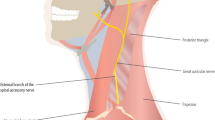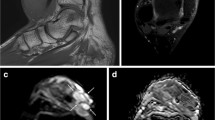Abstract
Objectives
To describe the MRI appearance of traumatic neuromas on non-contrast and contrast-enhanced MRI sequences.
Methods
This IRB-approved, HIPAA-compliant study retrospectively reviewed 13 subjects with 20 neuromas. Two observers reviewed pre-operative MRIs for imaging features of neuroma (size, margin, capsule, signal intensity, heterogeneity, enhancement, neurogenic features and denervation) and the nerve segment distal to the traumatic neuroma. Descriptive statistics were reported. Pearson’s correlation was used to examine the relationship between size of neuroma and parent nerve.
Results
Of 20 neuromas, 13 were neuromas-in-continuity and seven were end-bulb neuromas. Neuromas had a mean size of 1.5 cm (range 0.6–4.8 cm), 100 % (20/20) had indistinct margins and 0 % (0/20) had a capsule. Eighty-eight percent (7/8) showed enhancement. All 100 % (20/20) had tail sign; 35 % (7/20) demonstrated discontinuity from the parent nerve. None showed a target sign. There was moderate positive correlation (r = 0.68, p = 0.001) with larger neuromas arising from larger parent nerves. MRI evaluation of the nerve segment distal to the neuroma showed increased size (mean size 0.5 cm ± 0.4 cm) compared to the parent nerve (mean size 0.3 cm ± 0.2 cm).
Conclusion
Since MRI features of neuromas include enhancement, intravenous contrast medium cannot be used to distinguish neuromas from peripheral nerve sheath tumours. The clinical history of trauma with the lack of a target sign are likely the most useful clues.
Key Points
• MRI features of neuromas include enhancement and lack of a target sign.
• Contrast material cannot be used to distinguish traumatic neuromas from PNSTs.
• Traumatic neuromas can simulate peripheral nerve neoplasms on imaging.




Similar content being viewed by others
References
Huber CG, Lewis D (1920) Amputation neuromas. Arch Surg 1:85
Swanson HH (1961) Traumatic neuromas: a review of the literature. Oral Surg 14:317–326
Matthews GJ, Osterholm JL (1972) Painful traumatic neuromas. Surg Clin N Am 51:1313–1324
Enzinger FM, Weiss SW (1995) Soft tissue tumors. Mosby, St Louis
Murphey MD, Smith WS, Smith SE, Kransdorf MJ, Temple HT (1999) From the archives of the AFIP. Imaging of musculoskeletal neurogenic tumors: radiologic-pathologic correlation. RadioGraphics 19:1253–1280
Chhabra A, Williams EH, Wang KC, Dellon AL, Carrino JA (2010) MR neurography of neuromas related to nerve injury and entrapment with surgical correlation. Am J Neuroradiol 8:1363–1368
Carroll SL, Larry RS (2009) Wallerian degeneration encyclopedia of neuroscience. Academic Press, Oxford, pp 485–491
Seddon H (1943) Three types of nerve injury. Brain 66:237–288
Sunderland S (1951) A classification of peripheral nerve injuries producing loss of function. Brain 74:491–516
Bendszus M, Wessig C, Solymosi L, Reiners K, Koltzenburg M (2004) MRI of peripheral nerve degeneration and regeneration: correlation with electrophysiology and histology. Exp Neurol 188:171–177
Stanisz GJ, Midha R, Munro CA, Henkelman RM (2001) MR properties of rat sciatic nerve following trauma. Magn Reson Med 45:415–420
Titelbaum DS, Frazier JL, Grossman RI, Joseph PM, Yu LT, Kassab EA et al (1989) Wallerian degeneration and inflammation in rat peripheral nerve detected by in vivo MR imaging. AJNR Am J Neuroradiol 10:741–746
Cudlip SA, Howe FA, Griffiths JR, Bell BA (2002) Magnetic resonance neurography of peripheral nerve following experimental crush injury, and correlation with functional deficit. J Neurosurg 96:755–775
Boutin RD, Pathria MN, Resnick D (1998) Disorders in the stumps of amputee patients: MR imaging. AJR 171:497–501
Singson RD, Feldman F, Staron R, Fechtner D, Gonzalez E, Stein J (1990) MRI of postamputation neuromas. Skelet Radiol 19:259–262
Singson RD, Feldman F, Slipman CW et al (1987) Postamputation neuromas and other symptomatic stump abnormalities: detection with CT. Radiology 162:743–745
Wadhwa V, Lee PP, Strome GM, Suh KJ, Carrino JA, Chhabra A (2014) Spectrum of superficial nerve-related tumor and tumor-like lesions: MRI features. Acta Radiol 55:345–358
Kline DG (1982) Timing for exploration of nerve lesions and evaluation of neuroma-incontinuity. Clin Orthop 163:42
Quan D, Bird S (1999) Nerve conduction studies and electromyography in the evaluation of peripheral nerve injuries. Univ Pa Orthop J 12:45–51
Bhargava R, Parham DM, Lasater OE et al (1997) MR imaging differentiation of benign and malignant peripheral nerve sheath tumors: use of the target sign. Pediatr Radiol 27:124–129
Takahashi M, Sato K, Miura T (1993) MR imaging of musculoskeletal sarcomas: the clinical significance of peritumoral low signal intensity lines in planning surgical margins. Nippon Seikeigeka Gakkai Zasshi 67:881–896
Lin J, Martel W (2001) Cross-sectional imaging of peripheral nerve sheath tumors. AJR 176:75–82
Pindrik J, Chhabra A, Belzberg AJ (2013) Update on peripheral nerve surgery. Neurosurgery 60:70–77
Seitz RJ, Reiners K, Himmelmann F, Heininger K, Hartung HP, Toyka KV (1989) The blood-nerve barrier in Wallerian degeneration: a sequential long-term study. Muscle Nerve 12:627–635
Aagaard BD, Lazar DA, Lankerovich L, Andrus K, Hayes CE, Maravilla K et al (2003) High-resolution magnetic resonance imaging is a noninvasive method of observing injury and recovery in the peripheral nervous system. Neurosurgery 53:199–203
Liao C-D, Zhang F, Guo R-M, Zhong X-M, Zhu J, Wen X-H et al (2012) Peripheral nerve repair: monitoring by using gadofluorine M–enhanced MR imaging with chitosan nerve conduits with cultured mesenchymal stem cells in rat model of neurotmesis. Radiology 262:161–171
Kimura J (2013) Mononeuropathies and entrapment syndromes In: Kimura J (ed) Electrodiagnosis in diseases of nerve and muscle: principles and practice. Oxford press, pp 756–807
Spinner RJ, Kline DG (2000) Surgery for peripheral nerve and brachial plexus injuries or other nerve lesions. Muscle Nerve 23:680–695
Roganovic Z, Pavlicevic G, Petkovic S (2005) Missile-induced complete lesions of the tibial nerve and tibial division of the sciatic nerve: results of 119 repairs. J Neurosurg 103:622–629
Belzberg AJ (2005) Acute nerve injuries. Principles of neurosurgery, 2nd edn. Elsevier, Philadelphia
Acknowledgments
The scientific guarantor of this publication is Shivani Ahlawat. The authors of this manuscript declare no relationships with any companies whose products or services may be related to the subject matter of the article. The authors state that this work has not received any funding. LMF - AUR-General Electric Radiology Research Fellowship (GERRAF) 2008-2010, Siemens Medical Systems, 2011-2012, Sarcoma Grant Program, Johns Hopkins, current.
No complex statistical methods were necessary for this paper. Institutional Review Board approval was obtained. Written informed consent was waived by the Institutional Review Board. The publication did not include animals. No subjects or cohorts have been previously reported. Methodology: retrospective, observational, performed at one institution.
Author information
Authors and Affiliations
Corresponding author
Rights and permissions
About this article
Cite this article
Ahlawat, S., Belzberg, A.J., A. Montgomery, E. et al. MRI features of peripheral traumatic neuromas. Eur Radiol 26, 1204–1212 (2016). https://doi.org/10.1007/s00330-015-3907-9
Received:
Revised:
Accepted:
Published:
Issue Date:
DOI: https://doi.org/10.1007/s00330-015-3907-9




